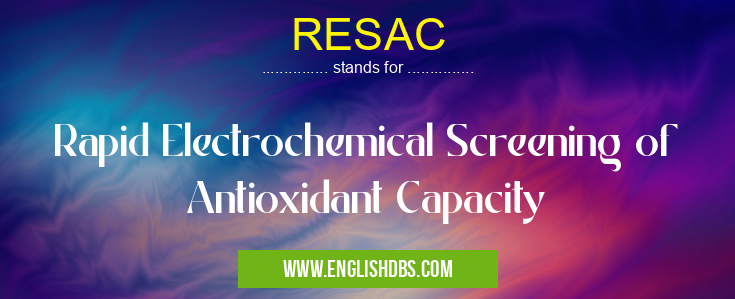What does RESAC mean in CHEMISTRY
Rapid Electrochemical Screening of Antioxidant Capacity (RESAC) is an advanced electrochemical technique that measures the antioxidant capacity of various substances. It involves the use of an electrochemical cell to evaluate the ability of antioxidants to scavenge free radicals.

RESAC meaning in Chemistry in Academic & Science
RESAC mostly used in an acronym Chemistry in Category Academic & Science that means Rapid Electrochemical Screening of Antioxidant Capacity
Shorthand: RESAC,
Full Form: Rapid Electrochemical Screening of Antioxidant Capacity
For more information of "Rapid Electrochemical Screening of Antioxidant Capacity", see the section below.
RESAC Methodology
RESAC employs a three-electrode system consisting of a working electrode, a reference electrode, and a counter electrode. The working electrode is typically made of carbon or gold, while the reference electrode is commonly a silver/silver chloride (Ag/AgCl) electrode.
The sample containing antioxidants is introduced into the electrochemical cell, and a potential is applied between the working and reference electrodes. Free radicals are generated at the working electrode, which react with the antioxidants in the sample. The current produced during this reaction is measured and used to determine the antioxidant capacity of the sample.
Advantages of RESAC
- Rapid: RESAC provides quick results, allowing for efficient screening of numerous samples.
- Sensitive: It can detect even low concentrations of antioxidants.
- Reproducible: The technique produces consistent and reliable measurements.
- Versatile: RESAC can be applied to a wide range of samples, including biological fluids, foods, and beverages.
Applications of RESAC
RESAC has various applications in different fields:
- Food Science: It is used to evaluate the antioxidant content of food products, helping to promote overall nutritional value.
- Clinical Research: RESAC aids in understanding the role of antioxidants in health and disease, contributing to the development of therapeutic interventions.
- Materials Science: It helps in assessing the antioxidant properties of materials, such as coatings and polymers, which can enhance their durability and longevity.
Essential Questions and Answers on Rapid Electrochemical Screening of Antioxidant Capacity in "SCIENCE»CHEMISTRY"
What is Rapid Electrochemical Screening of Antioxidant Capacity (RESAC)?
RESAC is an advanced electrochemical technique used to evaluate the antioxidant capacity of various substances. It measures the ability of substances to neutralize free radicals, which are highly reactive molecules that can cause oxidative stress and damage to cells and tissues.
How does RESAC work?
RESAC utilizes a working electrode that is coated with a film containing antioxidants. When the electrode is immersed in a sample containing free radicals, the antioxidants in the film react with the free radicals, reducing their concentration. This reaction generates an electrical signal that is measured and quantified, providing an indication of the antioxidant capacity of the sample.
What are the advantages of RESAC?
RESAC offers several advantages:
- Rapid and efficient: It provides quick results within a few minutes, making it a practical screening tool for antioxidant analysis.
- High sensitivity: RESAC can detect very low levels of antioxidants, allowing for precise measurements.
- Reproducible: The technique is highly reproducible, ensuring consistent results across different experiments.
- Versatility: RESAC can be used to evaluate a wide range of samples, including foods, beverages, dietary supplements, and biological fluids.
How is RESAC data interpreted?
RESAC data is typically presented as a measure of antioxidant capacity, which is expressed in terms of the Trolox equivalent antioxidant capacity (TEAC). TEAC represents the amount of the antioxidant trolox that would have the same antioxidant capacity as the sample being tested. Higher TEAC values indicate greater antioxidant capacity.
What are the applications of RESAC?
RESAC has various applications, including:
- Food science: Evaluating the antioxidant content of foods and beverages.
- Nutritional research: Assessing the antioxidant capacity of dietary supplements.
- Clinical research: Studying the role of antioxidants in disease prevention and treatment.
- Environmental monitoring: Measuring antioxidant levels in environmental samples, such as water and soil.
Final Words: RESAC is a valuable tool for rapidly and accurately measuring the antioxidant capacity of various substances. Its versatility and adaptability make it a widely used technique in a range of fields, contributing to advancements in food science, clinical research, and materials development.
